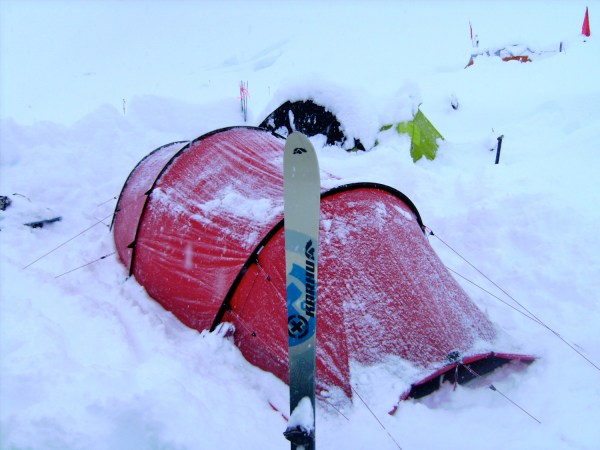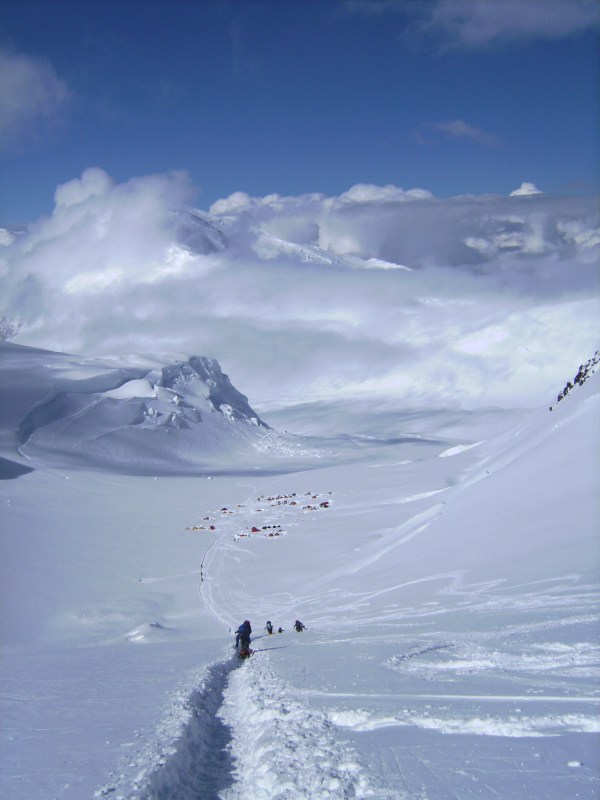Being a mountain guide is tough. It takes experience, grit and the ability to constantly put others’ needs before your own. I’ve been a mountain guide for three years, including two Denali trips. For this story, I drew on my personal guiding log from my last trip on the mountain to show you what a typical day is like for a Denali guide.

12:30am Ski Hill Camp
The smartphone tucked in my sleeping bag buzzes, and I scramble to turn it off so I don’t wake the other guides in the tent. This morning it’s my turn to cook, which means I’ll get up early and start boiling snow for water while everyone else is asleep. I pull on my puffy down pants, and then the shells of my double-plastic mountaineering boots and stomp outside. The tent is coated with a layer of snow from last night. Camp is quiet in the cool, clear twilight.
I stomp over to the cook tent and drag a burlap sack full of snow inside to melt for water. One by one, I get five stoves started—three to heat snow into water and then two to boil tepid water for hot drinks. I turn on the music in my headphones and rock out to my favorite music as warmth starts to creep through the frozen tent. This will be one of my few moments of aloneness for the day, and I soak up every minute of it.
1:00am
A few clients have made their way into the tent, and I ask one to step out and wake all the others. I pass around a thermos full of hot water so people can serve themselves coffee or hot cocoa. Today we’re going to move gear higher on the mountain to cache, so we need to do just a quick breakfast and go. Once there’s enough water to go around, I serve up cereal and full water bottles to everyone and then immediately start on dishes.
2:00am
My two co-guides are already laying out gear for the day. Today is a cache day—that means we will go up and over Ski Hill and leave a cache of gear buried in the snow before the next camp. This method helps us ferry our massive amounts of gear (at least 120 pounds per person) up the mountain. It also means we stick to the old mountaineering advice on acclimatization: climb high, sleep low.
3:00am
The clients have finally loaded up their packs and sleds with about 60 pounds of gear each. I walk around and check that their sleds are rigged properly, their backpacks look comfortable and their snowshoes are on. Then it’s time to do a safety check on harnesses and our rope system. I will lead a team of three clients, and the other two guides will also have three clients a piece on their rope teams.
3:30am
Time for the long, slow march. We start out along the glacier and we’re the only team in sight. We’re leaving this early in the morning so that we can go when the snow bridges are frozen and we’re less likely to punch through into a crevasse. I’ve gone in over my head in a crevasse before, so I don’t have any desire to repeat the experience. Fortunately we still have clear, cool weather and the snow is crunchy and firm.
We plod along and take a 10-minute break every 60 minutes on the dot. I try to pee, eat food, adjust layers, and check on all of my clients in that time, and usually only just make it.

8:30am
We arrive at the cache site an hour below the next camp. A sea of bamboo wands shows how many other parties have passed through. We look for a nice, flat spot and start to dig.
Guiding on Denali consists of two main things: shoveling snow and boiling snow. I’m pretty good at both by this point, but now it’s time to pull out my telescoping shovel and set to work. We work in shifts to dig the cache about 15 feet down and 7 feet in diameter in the snow—deep enough so that if it melts out at all the ravens won’t get our food.
11:00am
We’re back at camp. The clients collapse in their tents, and the other guides go about sorting gear leftover from the cache. I duck into the cook tent again and one by one fire up those stoves. Now it’s time to boil snow for dinner, and enjoy the glamorous life of a mountain guide.
